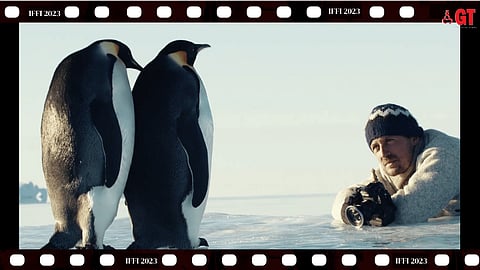

On Day 3 of the 54th IFFI (International Film Festival of India), in Goa, I happened to watch two films — a documentary and a feature film — both of which spoke about the complex relationship between the human and non-human world.
Both touched upon contemporary issues like climate change, man-animal conflict, disconnect between us and ecology, etc.
ABOUT THE FILMS
The first is a French documentary, Antarctica Calling by Luc Jacquet, who also directed The March of the Penguins. This visually stunning black and white film is about Jacquet’s journey to the South Pole and the reasons why he has been going to Antarctica and the penguins for over three decades now.
However, it is not a straight-forward documentation of his journey, but explores the inner feelings of Jacquet and his fascination for this piece of land and its creatures. The film also speaks about climate change, which is visible through diminishing snow cover, receding glaciers, etc.
While watching this documentary one ponders ‘can we really afford to lose this landscape in order to satisfy our greed for more?’ The movie ends on a happy note – the director’s encounter with the penguins, who are quite comfortable with his presence.
However, the recent news of the death of thousands of emperor penguin chicks due to the melting sea ice, leads one to the question: How long will we be able to admire these wonders of nature?
Examining such questions and the relationship between man and wild animals is the next film, Snow Leopard, by the late Tibetan director, Pema Tseden. It is an enigmatic tale about a snow leopard and its complicated relationship with communities of the Tibetan plateau.
The film starts with a local television crew’s journey to a remote village. They are covering the news of a snow leopard, who is trapped by villagers, as it killed nine rams in a single night. This makes the shepherd furious as he wants the local authorities to compensate him or otherwise he will kill ‘the beast.’
However, his brother, who is a monk, who otherwise loves to photograph this elusive creature, wants to release the snow leopard as, for him, it is not a beast but another living being, and he is full of compassion for it.
The movie speaks about the poignant issue of financial loss suffered by such shepherds due to the attacks by the snow leopard. However, in the traditional Tibetan community, the snow leopard is revered as it is considered the god of snow-capped mountains.
The director shows this conflict of belief well through its two main characters — the one who wants to kill, and another who wants to save.
The movie also shows how modernity has crept into their lives and how there is a disconnect in a very subtle way. It also makes another point: that it is easy and convenient for city dwellers and authorities to say ‘save these wild cats’, but the ground the reality is very different considering that the shepherds are already suffering and are struggling to make ends meet.
The movie also reflects on how, for centuries, the shepherds have shared a cordial relationship with these high-altitude cats and how, because of them, they have still managed to survive.
Both these movies reflect on current issues which surrounded us. These are not just issues seen in remote parts of the world, but impact us all since we are all interconnected.
I believe both these movies speak about this bond that we have with our ecology and how we need to have an empathetic lens to look at it.